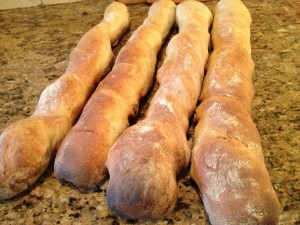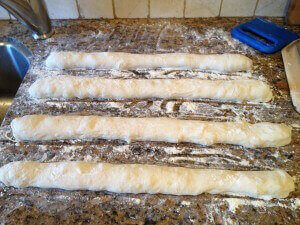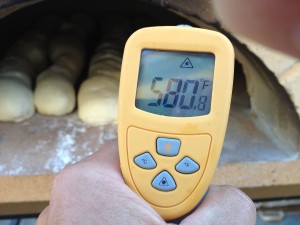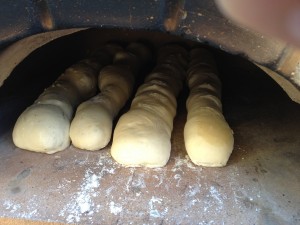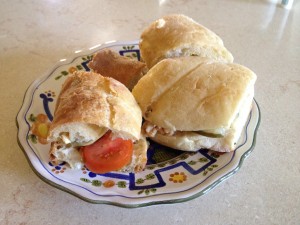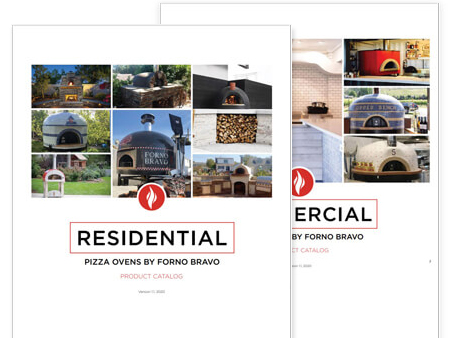Bread in a Small Pizza Oven
May 07, 2012Posted by Forno BravoI had a lot of fun working with a prototype of the not-yet-released Presto oven (it is coming soon, though) this weekend, and one of the capabilities I wanted to test was bread baking. Baguettes to be more specific. Spoiler alter—it came out great.
Here’s a little background information. I wanted to shoot for traditional, light, airy, crusty French baguette, so I choose general purpose flour from Trader Joe’s. For those of you who don’t have a local Trade Joe’s, or haven’t bought your flour there, Trader Joe’s used to sell King Arthur flour, including general purpose and white whole wheat. As TJ’s changed its strategy to selling home brands almost exclusively, the King Arthur flour disappeared and it was replaced by TJ’s brand general purpose and white whole wheat. Considering that the white whole wheat flour was a product that King Arthur developed and promoted, I have always assumed that TJ’s flour is still made by King Arthur.
I asked them by email a while ago, and while they answered my email, they didn’t answer my question (haha), so I guess we’ll never know.
You might also be wondering why I didn’t use bread flour. I have always thought of the baguette as a bread for the masses. It isn’t a work of art, it isn’t noble, and it doesn’t last. It’s the original fast food. It goes stale quickly, which is why French bakeries bake it in the morning and the afternoon, and I think it is stale baguettes which underlie the French obsession with buying bread. Morning, noon and night. A high quality general purpose flour is just right for the task at hand.
My plan was to make a simple dough. No pre-fermentation, no ice water, no sourdough. I weighed and mixed 1kg (2.2 lbs) of flour, with 10 grams of yeast, 20 grams of salt and 700 gram of water (70% hydration). I mixed the dough for 10 minutes on the level 2 setting on my KitchenAid stand mixer. The whole thing took only a minute or two to get started.
After a bulk fermentation of a couple of hours, and punched down the dough and then stretched, folded and shaped the dough ball. After a second rise, and cut the dough into four strips, and then shaped the baguettes—folding the loaves, stretching the outer edge of the dough, and sealing the fold at the bottom of the loaf.
But I’ve done that part before. The fun part that I wanted to see was how a small, 24” pizza oven would handle four 1 lb, 20” long baguettes. Sorry, another spoiler alter—it came out really well!
I have been curing (or am I doing a “dry out”?) my new oven for about a week, following the Forno Bravo curing instructions, and I am still baking water out of the oven dome. But today was the last day of curing, so going forward, my oven is ready for fast heat up to pizza temperature and for longer baking and roasting sessions. More to come on that later.
After bring the oven up to 1000ºF+, I shoveled out the coals and let the temperature moderate and then begin falling. One interesting aspect of a brick oven is that the moist baking environment allows you to bake bread at higher temperatures than you can in a conventional oven. In this case, I started baking my baguettes while the oven was still between 550-600ºF and the baguettes baked really well. If you tried doing that in your conventional oven, you would simply burn the outside of the bread, while the inside was still doughy.
I sprayed water inside the oven three times, and was rewarded with a really nice oven spring. The one thing I really need to work on is my slash technique—I have always had trouble getting a nice grigne (nice lip of crust) on baguettes. They are so light and delicate, that my slash never really takes hold. It’s a lot easier on a whole wheat miche.
The bread was really nice, and I did learn one thing about baking long loaves of bread in a small oven. Because the oven opening is so close to where the bread is baking, the back of the oven is hotter than the front. This became very clear in baking the long baguettes, which we done in the back, but still very pale in the front. Next time, I am going to turn them once.
We ate the bread for dinner the first evening, toast the next morning and sandwiches for lunch. In other words, pretty much the way your would eat a baguette while on vacation in France.
All-in-all, it was a very good experience. The bread was wonderful, far better than anything we could have bought from our local stores, and the oven experience was a blast. The oven performed like a champion (you could compare it to a Jack Russell terrier, who is convinced he’s as big as a Great Dane), and I learned more about my wood-fired bread baking hobby.
Time for more bread baking. Something with white whole wheat flour.



